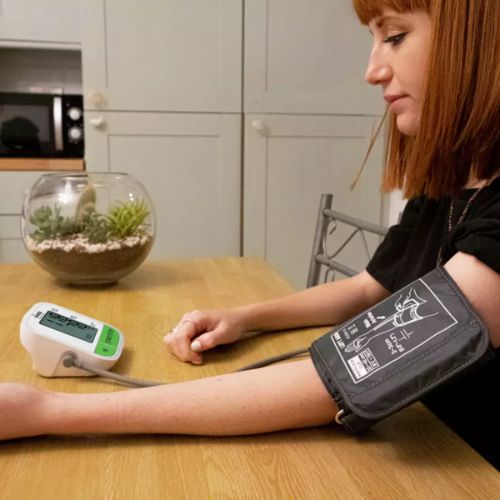Measuring your blood pressure at home can provide you and your doctor with valuable information on your health. Home monitoring helps track day-to-day blood pressure fluctuations and measure the effects of medications and lifestyle changes. This allows for more personalised treatment plans. When used correctly alongside professional care, home monitoring enables patients to take control of managing their blood pressure.
However, for home monitoring to be useful, it’s vital to choose an accurate, easy-to-use monitor and measure blood pressure correctly. This guide explains who can benefit from home monitoring, how to select the right equipment, and tips for reliable at-home readings.
Who Can Benefit from Home Blood Pressure Monitoring?
Home monitoring provides a more complete picture of someone’s true blood pressure than occasional clinic readings. Research shows home readings are often lower than at the doctor’s office due to reduced stress. This “white coat effect” means clinic tests alone may overestimate blood pressure in some patients.
Home monitoring also allows patients to check blood pressure more frequently. This helps identify trends over time and assess health interventions. Patients who could benefit include:
- Those diagnosed with hypertension needing regular monitoring.
- Individuals with suspected “white coat syndrome”.
- People with fluctuating blood pressure readings.
- Those starting new blood pressure medications.
- Patients making intensive lifestyle changes like diet and exercise.
However, home monitoring may cause anxiety for some people. Discuss with your doctor if it is right for you. There are also some health conditions where home monitoring is not recommended, like arrhythmias or pregnancy.
Choosing the Right Home Blood Pressure Monitor
Several types of blood pressure monitors are available for home use. To get accurate, reliable results:
Opt for a Clinically Validated Monitor
Check your monitor is independently tested and approved for accuracy. The British and Irish Hypertension Society provides lists of validated arm-cuff monitors and professional office monitors. Using a clinically validated device ensures your results are trustworthy.
Select an Automatic Upper Arm Monitor
Fully automatic arm cuff monitors are the easiest to use accurately at home. They inflate the cuff and use sensors to detect blood flow. Avoid wrist or finger monitors as they are less reliable.
Use the Correct Cuff Size
Most monitors come with a medium cuff, but you may need a different size for accurate readings. Measure your arm midway between shoulder and elbow to see if you need a small, medium or large cuff. Using the wrong size can significantly impact results.
Consider Budget but Don’t Skimp on Quality
Simple but validated monitors start around £20. More expensive machines typically include extra features like data storage – useful but not essential. Focus on finding a clinically approved monitor within your budget.
Learn Proper Technique
Carefully read the instructions and have your doctor or nurse check your process for the first use. Learning proper positioning and use is vital for accurate readings at home.
Tips for Reliable At-Home Blood Pressure Measurement
With the right validated monitor and a proper technique, you can reliably measure your blood pressure at home. Here are tips for accurate readings:
- Sit quietly for 5 minutes before starting.
- Avoid caffeine, smoking, exercise and big meals 30 minutes prior.
- Sit with back straight, feet flat, and arm supported at heart level.
- Take readings at the same time each day for consistency.
- Do 2-3 readings per session and record the average.
- Keep your arm and the cuff completely still during measurement.
- Wait 1-2 minutes between consecutive readings.
- Take readings both morning and evening for a complete daily view.
- Compare your figures to your target blood pressure range.
- Flag unusually high or low results for your doctor.
- Calibrate your monitor every 1-2 years as recommended.
Accurately monitoring at home allows you to spot trends and provide your doctor with helpful data. But remember to still attend regular clinic check-ups as well.
Interpreting Your At-Home Blood Pressure Readings
Use a blood pressure log to record your at-home results chronologically. This helps you and your doctor assess progress. As a guide:
- Less than 120/80mmHg is considered optimal blood pressure.
- Between 120-129/80-84mmHg is elevated but still normal.
- 130-139/85-89mmHg is stage 1 hypertension. Lifestyle changes are recommended.
- Equal to or above 140/90mmHg is stage 2 hypertension. Medication may be needed.
However, target ranges can vary by individual, so always discuss your results with your doctor. Sudden spikes or dips may indicate problems requiring assessment.
Some monitors come with built-in colour indicators for different blood pressure zones. But don’t overly rely on these – check your readings against your doctor’s advice instead.
Benefits and Limitations of Home Blood Pressure Monitoring
When used correctly alongside professional care, home monitoring provides many advantages:
Benefits
- Identifies white coat syndrome.
- Detects masked hypertension.
- Allows frequent, regular measurement.
- Monitors effects of interventions.
- Empowers patients in self-care.
- Reduces clinical workload.
- Minimises treatment costs.
Limitations
- Can increase anxiety in some.
- Requires proper technique.
- Needs regular calibration.
- May still miss night-time rises.
- Oversimplifies complex issues.
- Can foster self-diagnosis.
Overall, home monitoring enhances blood pressure control when used to complement regular check-ups. Discuss incorporating home measurement into your hypertension management plan.
Helpful Resources for Home Monitoring
Home monitoring places diagnostic power in patients’ hands. Make the most of this opportunity with tools like:
- Blood Pressure UK’s blood pressure log template to track and record your results.
- Instructional videos on measuring technique.
- Lifestyle change guides to lower your blood pressure through diet, exercise, sleep and more.
Monitoring at home is most effective as part of a holistic approach to controlling your blood pressure. Access resources to make it a valuable addition to your treatment plan.
In summary, home blood pressure monitoring provides patients and doctors greater insight when done properly. Select a suitable validated monitor, learn correct technique, and integrate readings into your overall care. Used right alongside medical advice, home monitoring enables you to take charge of your health.
Photo by Kinetik Wellbeing
Zoom Health is a leading UK supplier of Home Health Tests and Earplugs





